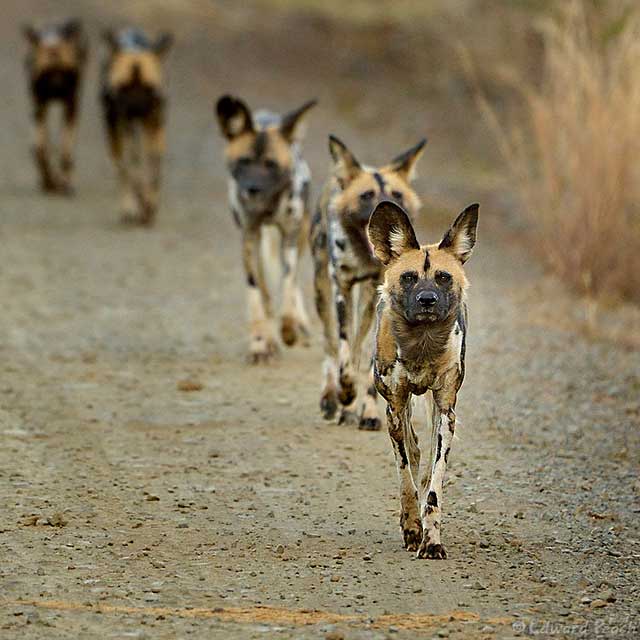
The African wild dog, also known as Cape hunting dog or painted wolf, is highly endangered, so consider yourself blessed if you can find them and photograph them in the wild!
In southern Africa wild dogs can be found in most national parks, but not in the arid parks such as Etosha in Namibia or the Kgalagadi Transfrontier Park in South Africa. Your best chance of seeing these rare animals will be to visit the Kruger National Park and Pilanesberg in South Africa, or the northern Botswana reserves, such as Chobe National Park, Okavango Delta and Moremi Game Reserve.
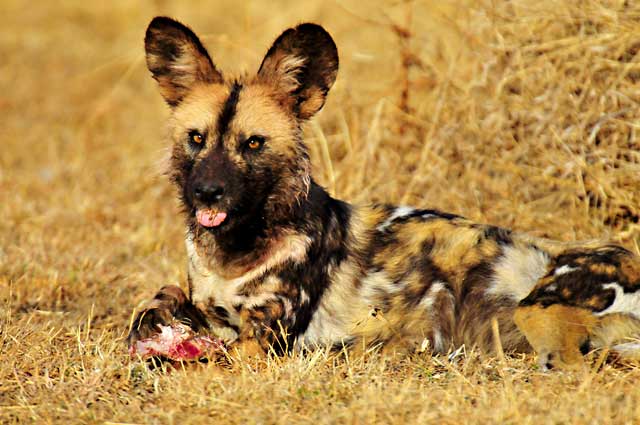
ABOUT AFRICAN WILD DOGS:
They are most active early mornings and late afternoons. If you find them resting during the day they will most likely stay there until the temperatures start to drop.
When they are on the move you will most often see them trotting in single-file on the roads or tracks with their heads bobbing up and down. Once they see a target (impala, waterbuck, kudu, etc.) they sprint after it so you will have a hard time keeping up with them!
They tend to crisscross from one side of the road to the other, so if you lose sight of them as they zigzag into the bushes, just stay put, as they may come back to the road once again, giving you the opportunity to ‘stop them in their tracks’ with your camera.
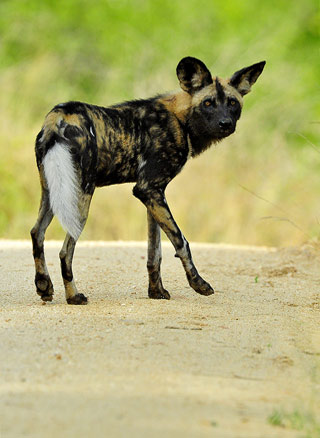
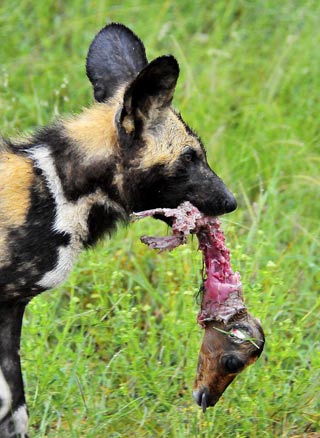
Hunting is a co-operative effort and all members of the pack, except pups and the injured, take part in the hunt.
Wild Dogs do not stalk their prey, they hunt by running down their prey in loose groups and then biting or latching onto their prey until it falls. It is not a nice thing to watch, as the prey is torn apart. Because of this way of killing, the African wild dog has been persecuted.
Farmers and hunters have shot and killed most of them, hence their endangered status. It’s interesting that the Hyena kills in the same way, but since most people think that they are just scavengers, so they are not persecuted in the same way.
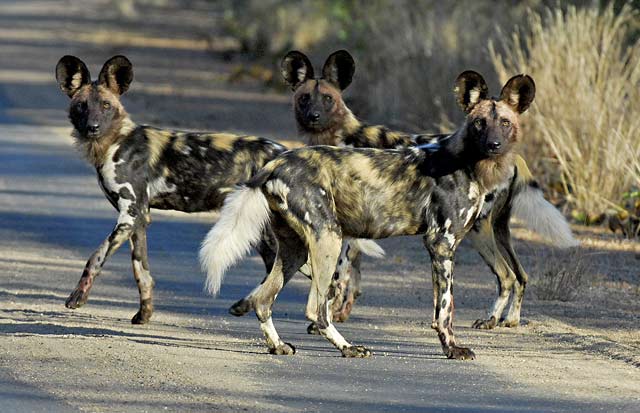
Unlike the lion, there is no jostling and fighting after a kill has been made, so photographing the dogs is not easy as the pack surrounds the victim with their heads down while eating – all you can see are bums and tails!
Just keep your camera ready to photograph the action, as individuals start ripping body parts off and then other dogs chase them and try to get the meat! Don’t zoom in too much, as they flick their long white tails.
You’ll not want to take the chance of cropping that feathery white ‘flag’ out of your image, so zoom out a bit more to allow for the tail movements.
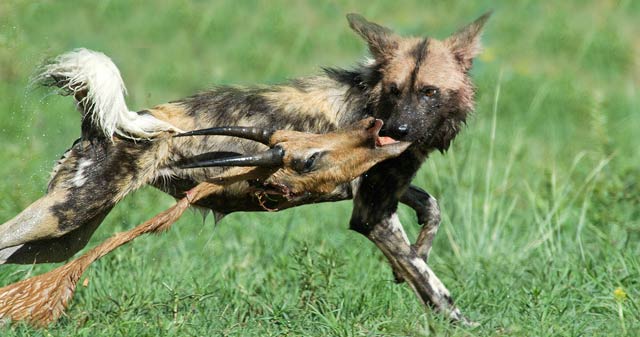
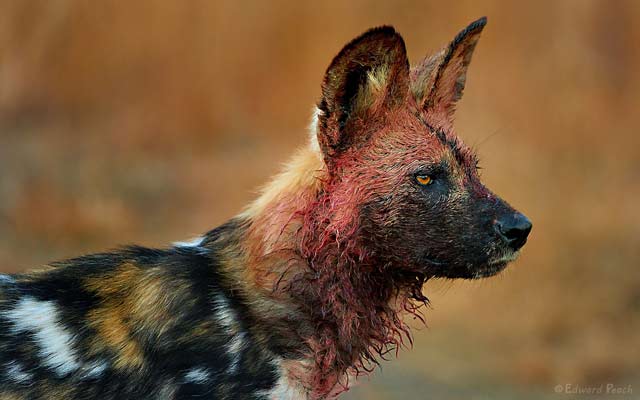
Winter is the best time to see pups at a den, because this is their breeding season and the grass tends to be shorter.
Following a gestation period of 10 weeks, a litter of between two to eight pups is born in a den or cave – one of which may be reused year after year. The pups are born blind and with almost no fur. They suckle for about two months and then are weaned onto regurgitated meat.
While the pups are small the dogs tend to stay near their dens for around nine months, so once you know that a pack of dogs have a den, keep a look out in that area as they will stick around for some time.
This will give you great photographic opportunities to make images of their comings and goings from the den.
Some other behaviors to watch for are jumping up on their back legs as they look for prey, playing, grooming each other, nuzzling and mouthing (they lick inside each other’s mouths as they regurgitate meat).
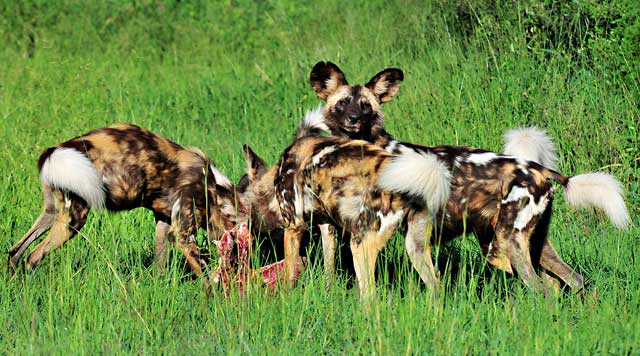
Wild dogs communicate by calling, which can be from a low growl-like bark to a high pitched chattering which they usually do while hunting or greeting each other. Other forms of communication are through sight and smell.
You may see flashes of white tails bobbing up in the long grass. This is an indication that wild dogs are in the area, so keep the camera close and get ready for the action.
WHAT PHOTO GEAR IS NEEDED?
We have photographed African wild dogs with lenses ranging from a 20mm wide angle to a 600mm f4 lens. An 80-400mm and 200-400mm f4 lenses tend to be the most used as the wild dogs dart around very quickly and you will need the zoom capability to zoom in and out as the dogs move towards and away from you.
We use beanbags whether we are doing a self-drive or a guided safari. We use a panning plate on an Apex beanbag and have found that to be a better combination than a window bracket and gimbal head. If we are photographing from the camps, then we use a tripod and gimbal head.
Most wild dog activity happens under low light – around dusk and dawn – so a camera with high ISO and low noise capability will be a big advantage.
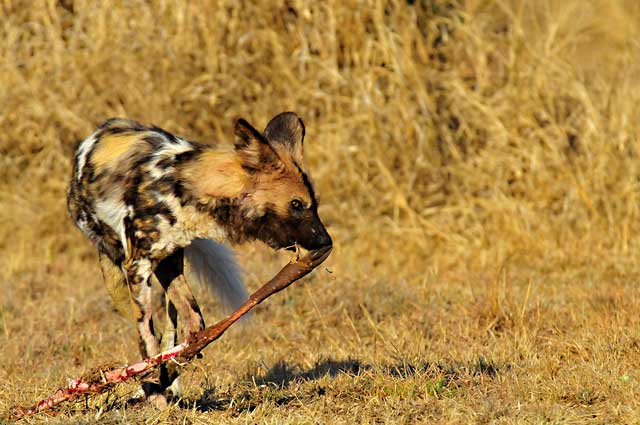
The coloration of wild dogs ranges from white through various shades of beige to black on each individual – hence the name ‘painted wolves’!
Most modern digital cameras should have no problem exposing the dogs correctly, but the dark eyes could be a problem when creating portraits. When exposing on their face, try and look for a lighter area around the eye on which to expose.
Alternatively bracket your shots or shoot RAW so you can adjust exposure in post processing.
THE PARKS:
The Kruger National Park
Location: The Park is situated in north-eastern South Africa, bordering Mozambique and Zimbabwe.
Access: By road or air.
Facilities: There are over 20 park camps with accommodation ranging from camping, tents and chalets to large guest houses. In addition, there are five-star lodges in concessions within the park and in private game reserves outside the park forming the ‘Greater Kruger Park’.
Reservations: Can be made online on the SANParks website and directly with the private lodges.
Best Locations: Wild dogs can be seen all through the year from the north to the south with the southern Kruger being the most productive, especially around Skukuza, Crocodile Bridge and to the east of Berg en Dal camps. The private game reserves on the Kruger’s western border are also good for wild dogs – especially reserves such as Sabi Sand, Manyeleti and Timbavati.
Pilanesberg National Park
Location: The Park is situated in the North-West Province of South Africa in the remains of a volcano.
Access: By road or by air.
Facilities: There are seven main lodges in the park ranging from three to five stars and the accommodation choices are camping, tents or chalets.
Reservations: Can be made online with the various lodge groups – Legacy, Golden Leopard, Pilanesberg Private Lodge and African Anthology.
Best Locations: The dogs tend to keep to the park boundary as they chase prey into the perimeter fence and most of the lodges are built on or near the fence-line so the chances of seeing African wild dogs are quite good. They also den in the rocky outcrops on the perimeter, so if they have been seen in a certain area the best thing to do is drive slowly in that part of the park during early mornings and late afternoons.
by Mario Fazekas
All text & photos: © 2013 Mario Fazekas. All rights reserved.
Dogs in road and blood stained face photos: © 2013 Edward Peach. All rights reserved.

Dear Apogeephoto.com,
I would like to ask whether you would give me permission to copy 2 of the above photos of African Hunting dogs in pastel drawings I am interested in creating. I would credit you totally with the photo reference sources. Thank you.
Hi, If credit is given back, I’m sure that wont be a problem. thanks